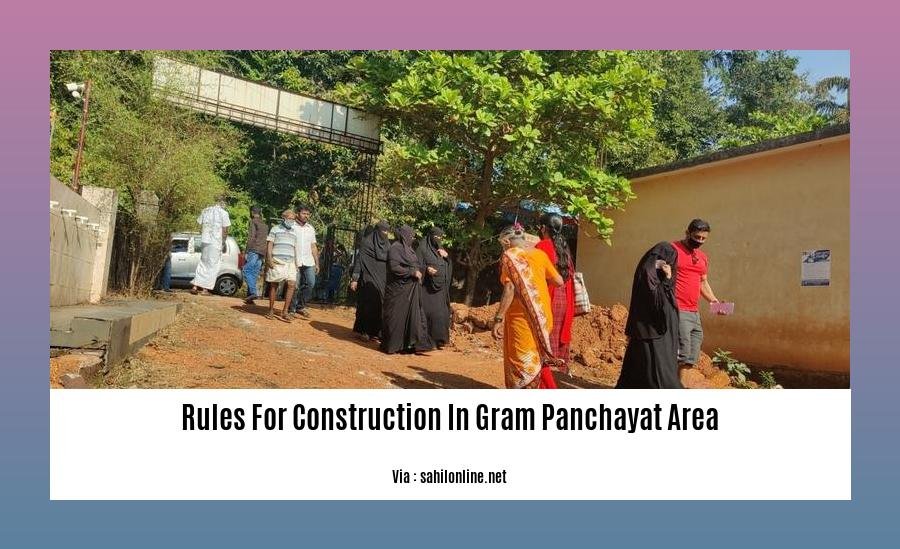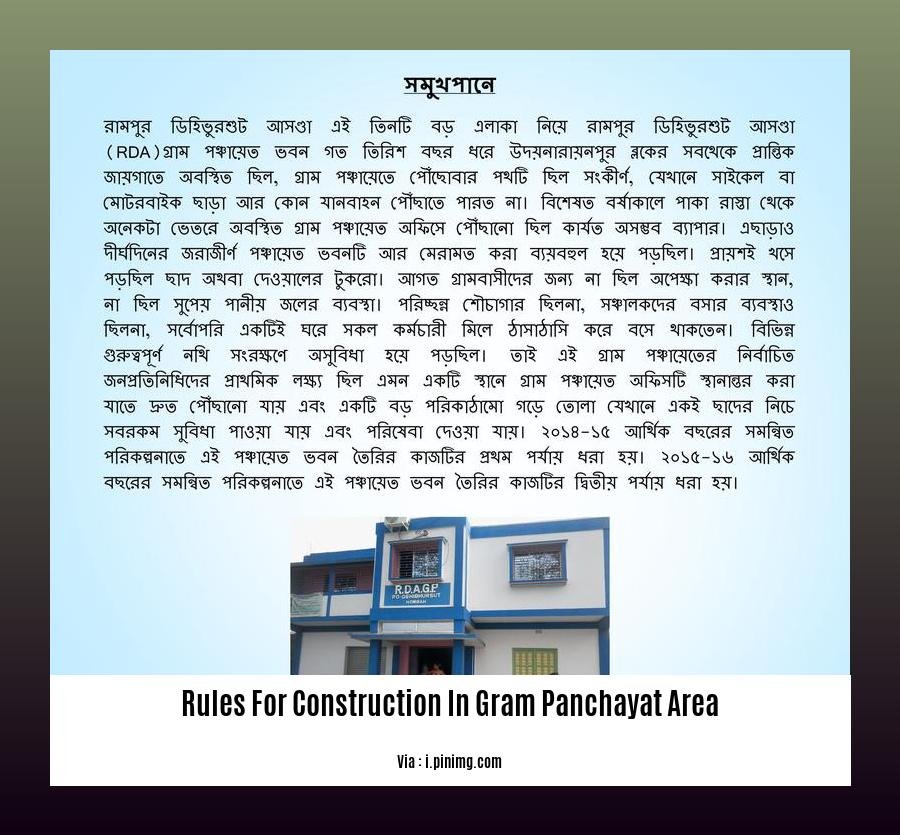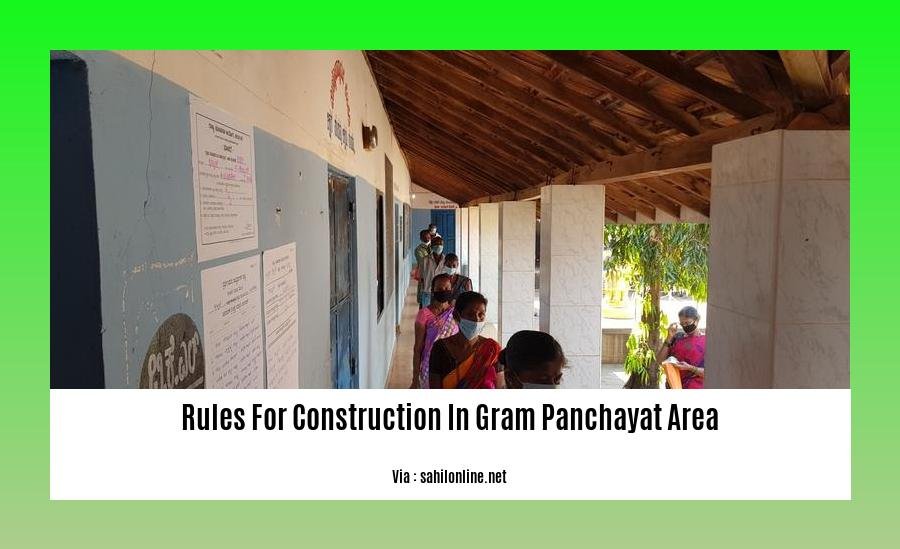Understanding the Rules for Construction in Gram Panchayat Areas
Gram panchayats, the grassroots units of local self-governance in rural India, play a crucial role in regulating construction activities within their jurisdiction. With the growing demand for infrastructure and development in rural areas, understanding the rules governing construction in gram panchayat areas is essential for ensuring compliance and fostering sustainable growth.
Key Takeaways:
- Obtain necessary permits and approvals from gram panchayat authorities.
- Adhere to building codes and regulations for structural safety.
- Comply with environmental safety standards to minimize environmental impact.
- Consider consulting qualified experts for compliance guidance.
- Be aware of boundary wall regulations specific to the gram panchayat.
- Note that using agricultural lands for non-agriculture purposes may be considered illegal.
Rules for Construction in Gram Panchayat Area

Before embarking on any construction project within a gram panchayat area, it’s crucial to be well-versed with the specific rules and regulations governing such endeavors. These rules are in place to ensure the safety, quality, and orderly development of our communities.
Key Considerations
1. Permits and Approvals:
- Obtain necessary building permits and approvals from the local gram panchayat authorities. These documents serve as legal authorization for your construction activities.
2. Building Codes and Regulations:
- Adhere strictly to the building codes and regulations established by the gram panchayat. These codes specify minimum standards for structural integrity, safety, and environmental impact.
3. Environmental Safety Standards:
- Ensure your construction activities comply with environmental safety standards to minimize negative effects on the surrounding ecosystem.
4. Qualified Experts:
- Consider consulting with qualified architects or engineers to ensure compliance with all relevant rules and regulations. Their expertise can save you time, money, and potential legal issues.
5. Boundary Wall Regulations:
- Be aware of any specific regulations regarding the height and design of boundary walls in your gram panchayat area. These may vary from region to region.
6. Illegal Construction:
- Avoid using agricultural lands within gram panchayat areas for residential or commercial purposes unless explicitly permitted. Such actions are generally considered illegal.
Benefits of Adhering to Rules
Complying with the rules for construction in gram panchayat areas offers numerous benefits, including:
- Safe and Durable Structures: Proper adherence to building codes ensures the construction of safe and durable structures that can withstand various environmental conditions.
- Community Safety: Following environmental safety standards helps protect the health and well-being of the local community by minimizing pollution and other hazards.
- Legal Compliance: Obtaining permits and approvals, and adhering to building codes, safeguards you against legal consequences and potential penalties.
Conclusion
Understanding the rules for construction in gram panchayat areas is essential for responsible and compliant construction projects. By following these regulations, you can contribute to the development of safe, sustainable, and thriving communities.
If you want to know more about the rules for construction workers like their code of conduct and dress code, check out our rules and regulations for construction workers page.
To understand the difference between the roles of a real estate developer and a construction manager, read our guide on real estate developer vs construction manager.
Contractors can find the information they need in the road construction machinery section of our website, which has detailed information on the different types of machines used in road construction.
Legal Framework for Construction Regulation in Gram Panchayat Areas
Familiarizing yourself with the legal framework for construction regulation is paramount when embarking on any construction project within Gram Panchayat areas. Here’s a quick guide to help you navigate the complexities:
Key Takeaways:
- Understand the legal framework for construction regulation in your Gram Panchayat.
- Obtain necessary permits and approvals to ensure compliance.
- Adhere to building codes and regulations for safety and quality.
- Consult with qualified professionals for guidance and support.
- Be proactive in seeking information and staying updated on regulations.
Understanding the Legal Framework
The legal framework for construction regulation in Gram Panchayat areas typically comprises:
- Village Panchayat Act: Outlines the Gram Panchayat’s authority to regulate construction.
- Building Bye-Laws: Establishes specific rules and regulations for construction, including zoning, building standards, and safety measures.
- State and National Building Codes: Provides comprehensive guidelines for construction practices, ensuring adherence to quality and safety standards.
Permits and Approvals
Before commencing any construction project, you must obtain the necessary permits and approvals from the Gram Panchayat. This typically involves:
- Building Permit: Authorizes the construction or alteration of a building.
- Occupancy Certificate: Certifies that the building is safe for occupation.
- Other Permits: May be required for specific activities, such as electrical or plumbing work.
Building Codes and Regulations
Adhering to building codes and regulations is crucial for ensuring the safety and quality of your construction project. These regulations cover various aspects, including:
- Zoning: Designates areas for different land uses, such as residential, commercial, or agricultural.
- Building Standards: Specifies requirements for building materials, structural design, and fire safety.
- Environmental Regulations: Outlines measures to protect the environment from construction activities.
Consulting Professionals
Consulting with qualified professionals, such as architects or engineers, is highly recommended for guidance and support throughout the construction process. They can help:
- Interpret and comply with building codes and regulations.
- Design and plan your project to meet safety and quality standards.
- Provide technical expertise and ensure the project’s structural integrity.
Staying Informed
Construction regulations are subject to change, so it’s essential to stay updated on the latest amendments or updates in your Gram Panchayat. Regularly check with the local authorities or consult with professionals to ensure compliance.
Sources:
- Construction Rules in Gram Panchayat Area
- How to Draw a Plan for a Building Permit Under Panchayat Area
Common challenges in implementing construction regulations
Navigating the complexities of construction regulations in Gram Panchayat areas can be a formidable task. Here are some of the most pervasive challenges that local authorities face:
1. Lack of Awareness and Understanding
Inadequate understanding of regulatory frameworks among construction professionals and the public at large can lead to non-compliance. Raising awareness and providing accessible educational resources is crucial to address this issue.
2. Limited Resources and Capacity
Gram Panchayats often face resource constraints, including limited manpower and technical expertise, which can hinder their ability to effectively enforce construction regulations.
3. Lack of Accountability and Transparency
Unclear lines of accountability and a lack of transparent procedures can create loopholes and opportunities for malpractices. Establishing clear roles and responsibilities, and implementing transparent processes, is essential to ensure compliance.
4. Cultural and Social Pressures
Cultural practices and social pressures can influence construction practices in Gram Panchayat areas. It is important to engage with local communities and understand their perspectives to foster compliance with regulations while respecting cultural norms.
5. Lack of Robust Inspection and Enforcement Mechanisms
Inadequate inspection and enforcement mechanisms can result in non-compliance and subpar construction practices. Equipping local authorities with the necessary tools and resources to conduct regular inspections and enforce penalties is vital.
Key Takeaways:
- Enhancing Awareness: Educate construction professionals and the public about regulations and best practices.
- Empowering Local Authorities: Provide adequate resources, manpower, and training to Gram Panchayats.
- Establishing Accountability: Define clear roles and responsibilities, and implement transparent procedures.
- Engaging the Community: Collaborate with local communities to understand cultural factors and promote compliance.
- Strengthening Enforcement: Implement robust inspection and enforcement mechanisms to deter non-compliance.
Sources:
- Construction Rules in Gram Panchayat Area | Legal Guidelines
- Karnataka Gram Panchayat Act, 2015
Best practices for effective construction regulation

Construction regulations in gram panchayat areas ensure规范的建设实践and safeguard the safety and well-being of the community. By adhering to these regulations, local authorities can foster sustainable development and maintain the integrity of the built environment:
Obtaining Building Permits:
- Secure necessary permits from the local panchayat to ensure compliance with building codes and zoning regulations.
- Submit detailed plans, pay fees, and obtain approvals from relevant departments.
Adhering to Building Codes:
- Construct buildings in accordance with established building codes that address structural safety, energy efficiency, and accessibility standards.
- Ensure that the construction materials and techniques meet the prescribed specifications.
Environmental and Safety Standards:
- Implement measures to protect the environment and ensure the construction process is safe.
- Comply with environmental regulations, such as waste management and erosion control.
- Provide adequate safety equipment, follow proper site management practices, and ensure worker well-being.
Professional Guidance:
- Engage qualified architects and engineers to design and supervise the construction process.
- Seek professional advice to ensure compliance with regulations and best practices.
Inspection and Enforcement:
- Conduct regular inspections to monitor construction activities and ensure compliance.
- Enforce building codes and regulations through appropriate measures, such as stop-work orders, fines, or legal action.
Public Engagement:
- Involve the community in the construction planning process to gather feedback and address concerns.
- Provide clear information about building regulations and the permitting process.
Key Takeaways:
- Obtaining Permits: Ensure compliance with building codes and zoning regulations.
- Adhering to Building Codes: Construct buildings that meet structural safety, energy efficiency, and accessibility standards.
- Environmental and Safety Standards: Protect the environment and ensure the construction process is safe.
- Professional Guidance: Engage qualified professionals to design and supervise construction.
- Inspection and Enforcement: Monitor construction activities and enforce regulations to ensure compliance.
- Public Engagement: Involve the community to gather feedback and address concerns.
Sources:
- Construction Rules in Gram Panchayat Area | Legal Guidelines
- How to draw a plan for a building permit under Panchayat area
FAQ
Q1: What are the essential permits and approvals required for construction in gram panchayat areas?
Q2: How can I ensure that my construction project complies with the building codes and regulations in gram panchayat areas?
Q3: What environmental and safety standards must be followed during construction activities in gram panchayat areas?
Q4: Is it advisable to consult with qualified professionals when planning construction in gram panchayat areas?
Q5: What is the role of gram panchayats in regulating construction activities within their jurisdiction?
– A Comprehensive Guide to Rules for Construction in Gram Panchayat Areas
Navigating the intricate legal framework governing construction activities in Gram Panchayat areas can be a daunting task. However, understanding the rules and guidelines is crucial to ensure compliance and avoid potential legal complications. In this comprehensive guide, we will explore the essential regulations governing construction in Gram Panchayat areas, providing clear and concise explanations to empower you with the knowledge you need to embark on your construction project with confidence. [- A Comprehensive Guide to Rules for Construction in Gram Panchayat Areas]
Key
- Obtain necessary permits and approvals
- Adhere to building codes and regulations
- Follow environmental and safety standards
- Consult a qualified professional
- Consider restrictions on construction type
- Observe building height limits
- Maintain setbacks from property lines
- Comply with boundary wall provisions
- Meet green space requirements
Rules for Construction in Gram Panchayat Area
Before embarking on any construction project within a gram panchayat area, it’s crucial to understand the governing rules for construction in gram panchayat area. These regulations aim to ensure orderly development, maintain safety standards, and preserve the character of the community.
Key Considerations
-
Obtain Permits and Approvals: Securing building permits and approvals from the local Gram Panchayat is essential. This process typically involves submitting plans, paying fees, and adhering to specific requirements.
-
Building Codes and Regulations: Comply with the building codes and regulations established by the Gram Panchayat. These rules govern aspects such as structural safety, setbacks, and building heights.
-
Environmental and Safety Standards: Construction activities must meet environmental and safety standards set by the Gram Panchayat. These include measures to minimize noise, dust, and waste generation.
-
Professional Consultation: Consider consulting an architect or engineer for assistance with design and compliance. They can help ensure your project aligns with Gram Panchayat regulations.
Key Factors
-
Restrictions on Construction Type: Gram Panchayats may impose restrictions on the type of construction allowed, such as residential, commercial, or industrial.
-
Building Height Limits: Adhere to the minimum and maximum building heights specified by the Gram Panchayat to maintain visual harmony and prevent safety hazards.
-
Setbacks: Maintain the required setbacks from property lines to provide adequate space for roads, utilities, and emergency access.
-
Boundary Walls: Construct boundary walls as per the Gram Panchayat’s guidelines to define property boundaries and enhance security.
-
Green Space Provisions: Gram Panchayats may mandate the provision of green spaces within construction projects to promote environmental sustainability and aesthetics.
If you’re a construction worker, it’s essential to be aware of the rules and regulations that govern your industry.
In a construction project, understanding the roles is key. For that, you must know the difference between real estate developers and construction managers.
Construction projects are a lot more manageable when you have the right road construction machinery at your disposal.
Understanding Building Codes and Permits
It all begins with understanding building codes and permits. These are the cornerstones of construction in gram panchayats, ensuring that your projects are safe, legal, and environmentally sound.
Why are Building Codes and Permits Important?
Think of building codes as the blueprints for safe construction. They set forth specific requirements for the design, construction, and operation of buildings to protect the health, safety, and welfare of occupants and the general public.
Permits, on the other hand, are your green light to start building. By obtaining a permit, you demonstrate that your project meets the established codes and standards. It also brings you under the watchful eye of the gram panchayat, ensuring compliance throughout the construction process.
Key Takeaways:
- Building codes establish safety and quality standards for construction.
- Permits ensure that your construction project complies with these codes.
- Gram panchayats are responsible for enforcing building codes and issuing permits.
How to Obtain Building Permits in Gram Panchayat Areas?
Obtaining a building permit in a gram panchayat typically involves these steps:
- Submit plans and specifications of your proposed construction.
- Pay the required fees.
- Comply with building inspections throughout the construction process.
Resources:
- Construction Rules in Gram Panchayat Area | Legal Guidelines
- How to Draw a Plan for a Building Permit Under Panchayat Area
Exploring Environmental Considerations
Considering environmental considerations in construction projects ensures their sustainability and long-term viability. Gram panchayats, a vital part of local governance in India, have a significant role in overseeing construction activities and ensuring environmental standards are met.
Environmental considerations encompass a wide range of factors, including:
- Waste management: Proper disposal of construction waste is crucial to prevent pollution and environmental degradation.
- Water conservation: Efficient use of water during construction and the incorporation of water-saving fixtures can reduce environmental impact.
- Energy efficiency: Using sustainable materials, implementing energy-efficient measures, and harnessing renewable energy sources can minimize the carbon footprint of construction projects.
- Noise pollution: Mitigating noise during construction can be achieved through noise barriers, timing restrictions, and soundproofing techniques.
- Air pollution: Dust control measures, such as sprinklers or wind screens, help reduce air pollution during construction.
Key Takeaways:
- Gram panchayats play a key role in enforcing environmental standards in construction.
- Environmental considerations include waste management, water conservation, energy efficiency, noise and air pollution control.
- Compliance with environmental norms ensures sustainable construction practices and minimizes environmental impact.
Relevant URL Sources:
- Environmental Considerations in Construction Projects
- Environmental Considerations for Construction Projects
Ensuring Compliance and Enforcement Measures
Construction activities in gram panchayat areas must adhere to specific regulations. Ensuring compliance involves various measures to prevent illegal construction and maintain safety standards. Here’s how it works:
Inspection and Enforcement
Gram panchayats are responsible for inspecting construction sites and enforcing building codes. Inspections can identify violations, including unauthorized construction, deviations from approved plans, and non-compliance with safety regulations. If violations are found, enforcement actions can be taken, such as:
- Issuing stop-work orders
- Imposing fines
- Demolishing illegal structures
Penalties and Consequences
违反建筑法规的村庄可以面临严厉的处罚。罚款金额取决于违规的严重程度。在严重的情况下,非法建筑甚至可以被拆除。这些处罚对于遏制无证建筑和确保遵守建筑法规至关重要。
Building Permits
Obtaining a building permit from the gram panchayat is mandatory. The permit process involves submitting construction plans for review and approval. Plans must adhere to building codes and environmental regulations. Once approved, the permit serves as proof of compliance and allows construction to begin.
Key Takeaways:
- Gram panchayats enforce building codes through inspections and enforcement actions.
- Penalties for violations include fines, stop-work orders, and demolition.
- Building permits ensure compliance by requiring plans to meet building codes and environmental standards.
Sources:
- Construction Rules in Gram Panchayat Area
- How to Draw a Plan for a Building Permit Under Panchayat
FAQ
Q1: What is the process for obtaining a building permit in a Gram Panchayat area?
Q2: What are the key building codes and regulations that apply to construction in Gram Panchayat areas?
Q3: What environmental standards must be met for construction activities in Gram Panchayat areas?
Q4: What are the setbacks from property lines that are typically required for construction in Gram Panchayat areas?
Q5: What is the role of the Gram Panchayat in enforcing construction rules and regulations?
- Dora the Explorer Wipe-Off Fun: Safe & Mess-Free Activities for Little Explorers - April 18, 2025
- Does Lemongrass Repel Mosquitoes? Fact vs. Fiction + How to Use It - April 18, 2025
- Do Woodchucks Climb Trees?Fact vs. Fiction - April 18, 2025










